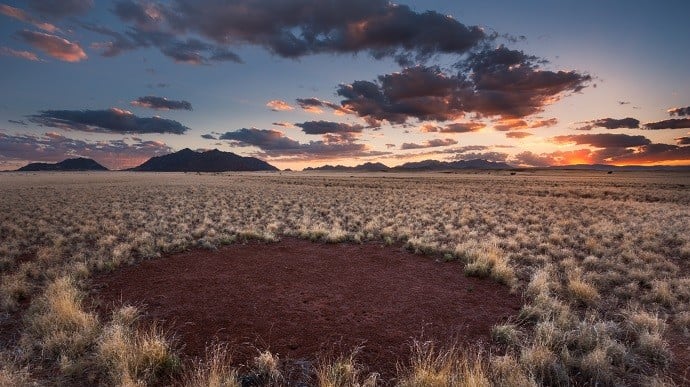University Of Pretoria State Microorganisms Could Be The Cause Of ‘fairy Circle’ Phenomenon
University of Pretoria (UP) scientists have posited a theory that could explain the tens of thousands of “fairy circles” that can be seen dotted across the arid landscape of Namibia.
The existence of these circles has fascinated scientists for decades, and no one knows the actual cause of this phenomenon. The Nama tribes believed the circles were caused by dragons. There are many competing theories of their origins – one of which is that microorganisms could be the missing piece of the puzzle, according to UP researchers.
Fairy circles are bare, regularly spaced and sized patches surrounded by grass. Most are between 2 and 5m in diameter, and they occur over thousands of square kilometres in Namibia and into southern Angola.
“These fairy circles are unique to Namibia and southern Angola,” says Professor Don Cowan, Director of UP’s Centre for Microbial Ecology and Genomics. Similar “structures” have been found in Australian deserts, but that doesn’t necessarily mean that they have the same causative basis.
A number of current theories could explain the phenomenon: toxic gasses from deep in the soil, toxic chemicals from dead Euphorbia plants, sand termites or the effects of natural plant “self-organisation” processes over long timescales could all have caused the formation of these circles. Each of these major theories is supported by a research group often purporting to have “discovered” the cause.
Prof Cowan and his team have investigated the cause of fairy circles and have their own theory: they think that plants growing inside the circles could be dying as a result of phytopathogenesis – the presence of pathogenic microorganisms (bacteria, fungi or viruses) in the soil.
The growth of fairy circles is reminiscent of a growing microbial culture, which is circular and spreads at the margins. While several other theories can explain plant death, they struggle to explain the growth of the circle itself.
“To test our theory, we used environmental DNA and modern metagenomic methods to investigate the bacterial and fungal diversity of soils inside the fairy circles and compared them with control soils outside circles,” Prof Cowan explains. “We found significant differences between these communities, but this is not causative proof – the usual difficulty of distinguishing between cause and effect. Environmental DNA – which is all the DNA that can be extracted from an environmental sample such as a gram of soil or water – provides access to the totality of organisms in that sample.
“Interestingly, some of the unique fungal species found only in the soils inside the fairy circles are known plant pathogens, though this is also not final proof that they cause the circles,” Prof Cowan explains. “Proof would only come from isolation of these fungi as cultures, and proof that they infect and kill the plant species.”
Some proponents of the various major theories tend to ignore contrary evidence, Prof Cowan says. “For example, proponents of the Euphorbia theory seem to ignore the fact that fairy circles exist extensively in the gravel desert areas where Euphorbias do not grow and may never have grown,” he explains.
There are suggestions that the effect that causes fairy circles may be complex, with possible secondary effects. Plants germinating inside fairy circles, as they do after rain, die quickly and seem to be more susceptible to drought. This implies the causative agent is somehow related to root function. “Perhaps there are multiple causes of localised plant death that generate these strange circular phenomena,” Prof Cowan says. “Fairy circle structures might be caused by sand termites eating roots in one desert area, while residual toxins in the soil from dead Euphorbia plants might be the cause in another, and pathogenic fungi in a third.”
The circles appear to have a lifespan – they seem to grow (expand) with the death of grass plants around the outer margin (which makes the circle larger). Plants around the edges of the circles actually grow taller and stronger than those on the outside, probably because they have less competition for nutrients and water, until they die as the circle expands.
The lifespan of a fairy circle may be about 40 years. “Interestingly, no one seems to report ‘newborn’ or very small fairy circles,” Prof Cowan says. “Certainly, I have never seen one. Maybe they are not as visible at that size.”
Studying these circles has been a great experience, Prof Cowan adds. “They are beautiful, intriguing and enigmatic, and I can see why so many scientists have focused their research on this phenomenon.”

